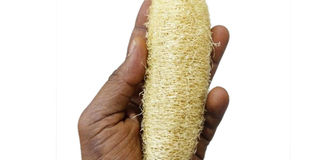Prime
Your loofah might be causing acne

What you need to know:
- While loofahs are good exfoliation agents, it is crucial to know that if not kept clean, one will only be bathing with yesterday’s dirt, which is less than pleasant.
- With the need to get rid of germs, bacteria and dirt, it is imperative that you thoroughly clean your loofah weekly.
Loofahs are popular shower accessories used to get rid of dirt from your skin. Dr Fiona Mutesi Magololo, a general practitioner, says natural loofahs are actually made from a vegetable gourd in the cucumber family. Loofahs exfoliate and cleanse skin, but they are not the best shower choice for everyone for various reasons such as the bacteria they can spread.
Dr Magololo says loofahs need to be taken care of properly so they do not become carriers of bacteria that could make you sick. More to that, they can also damage sensitive skin, moreso fresh natural loofahs. That is why some people may opt for artificial ones such as those made out of nylon thread.
Apart from exfoliating skin, which is usually done alongside soap, Dr Magololo says loofahs can also stimulate blood circulation as one showers.
Spreading bacteria
By nature, loofahs have lots of nooks, crannies and multiple pores. Owing to these, she says, fungi and bacteria can hide in them. “That is not forgetting dead skin cells, germs, dirt, oil and grime that we scrub off our bodies,” she adds.
Dr Magololo explains that when hot water hits our body, the skin pores open and a dirty loofah can propel bacteria into the skin.
“When you step out of the shower, the skin pores close from the cold and thus trap the bacteria inside them, leading to infection,” she says.
Dr Franklin Wasswa, a general practitioner, adds that loofahs have been proved to act as reservoirs and vehicles in transmission of potentially dangerous bacteria to human skin. “The growth of these organisms in the loofah is increased by dead skin cells entrapped in the loofah together with a wet environment,” he says.
He explains that microorganisms harboured in the loofah may result in skin conditions such as hypersensitivity reactions, hot tub folliculitis, bacterial folliculitis, abscesses and cellulitis.
Dr Magololo adds that washing open cuts with a loofah can also trap the bacteria in.
Care
Wash your loofah daily
Exfoliating causes dirt to be removed from your skin into your loofah. “Therefore, washing the loofah will help get rid of the dirt,” Dr Wasswa shares.
Shake it out well
Aware that a wet environment enhances the growth of bacteria, Dr Magololo says shaking your loofah reduces the amount of water it has.
Hang it to dry out
Usually, we hang our loofahs in the bathroom, which is a wet environment as well. However, to deny bacteria and germs from multiplying, hanging them in a cool place allows them to dry well. “However, hanging them under direct sunshine is not good as the sun rays will undermine its longevity,” Dr Wasswa adds.
Caution
Dr Wasswa reminds us to avoid using a loofah a few days after shaving since using a loofah on open skin makes one prone to infection.
Besides that, avoid using a loofah on your face and genitals as those body parts are sensitive. “You might want to use a towel instead lest you risk hurting yourself,” he says.
With the need to get rid of germs, bacteria and dirt, it is imperative that you thoroughly clean your loofah weekly. “Besides the daily washing, in a little bleach, soak your loofah and then rinse it thoroughly to ensure there is no bleach left. Thereafter, hung it to dry,” Dr Wasswa shares.
Alternatives
Dr Magololo shares that loofahs are not the only thing you can use to clean your body. “Considering other skin cleaning alternatives would be a great idea. For example, you may use wash cloths as they will leave your skin clean yet harbour fewer germs. This is because they are easier to wash and dry. More to that, their structure, unlike loofahs, does not allow as many microorganisms to lodge in,” she says.
While loofahs are good exfoliation agents, it is crucial to know that if not kept clean, one will only be bathing with yesterday’s dirt, which is less than pleasant. Interchanging between other body cleaning options and ensuring the loofah is clean will make your bath more beneficial.
Replace often
While you may not hang it under direct sunshine to preserve it, Dr Fiona Mutesi Magololo, a general practitioner, says it is important that you replace your loofah regularly. “If your loofah is natural, replacing it after every two to four weeks is ideal while the artificial one ought to be replaced after eight weeks,” she says adding that urgent replacement must be done in case your loofah has a musty smell or mould.
Dr Franklin Wasswa, a general practitioner, says if you feel itchy or experience redness after taking a bath, it is probably an alarm that you need to replace your loofah. “If you are experiencing skin dryness, you may also want to give the loofah a break as you may suffer skin irritation,” he warns.





